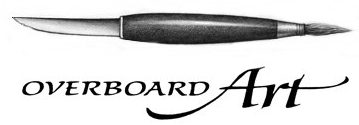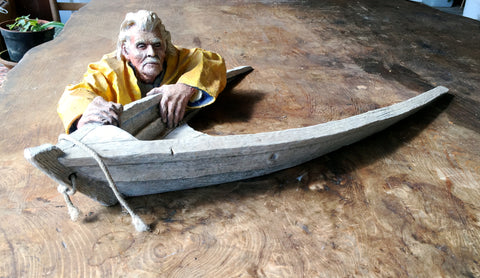The story around “Henry Overboard"
"Henry" is Henry Singer who lived nearby on a farm. I got to know him because he raised a wide variety of ducks, swan and geese, and other exotic birds on his farm along with cows, goats, sheep, mules and hogs. Henry was—he passed on maybe seven to nine years ago—considered one of the real characters in these parts. On my visits, I would take my sketchbook to draw his birds. He enjoyed it that I liked his birds. It wasn't too long before I discovered Henry was more interesting than his birds. His wife had left him long ago before I knew him when, as Henry told it, she said to him, "Its the birds or me?" You guessed it; Henry chose the birds.
Henry was definitely all about his animals, but in a disarmingly charming and innocent way. He knew he was totally unfit for human co-habitation, but enjoyed those who would visit if they would not be critical of the way he lived. Each animal having a name is not so unusual on a farm, but considering them full-fledged members of his family, as if they were human, was unique. He was especially fond of a goat named "Nanny". They were inseparable. Henry drove Nanny around with him in his beaten up rust bucket truck as others drive their dogs. Interestingly, Henry did not have a dog. Nanny had the run of the farm but, as far as I could tell, had one restriction. She was not allowed to sit on his antique heirloom sofa. I asked him about the sofa, since it was the only thing in the house he attempted to protect. He said it was a family heirloom from his parent’s home.
Once I was visiting and he invited me into the kitchen. It was summer so he had taken the door off so his animals could come in without having to knock. I walked in and the goat Nanny was sitting comfortably on his couch. Henry was always excited when I came. Some how I being an artist made me a special guest in his eyes. Seating me at the kitchen table, he offered coffee. "Sure," I replied, without knowing the implications.
Henry sets about looking for a clean pot to boil water. Not finding one quite clean enough, he looked around in his tool box at the foot of the table and eventually found a piece of sandpaper and began sanding the inside of the pot. Next, he handed me a cup. It looked like it had never been washed. Unsuccessful in hiding my dismay, he quickly reached back in the toolbox until he found a suitably clean piece of 80 grit sandpaper. Handing it to me, he suggested with his eyes I use it to clean the cup. In view of the hardened coffee rings, it seemed like an appropriate solution. While I sanded the cup, he dumped out the coffee in a pan, added water and soon had the mixture bubbling happily. It was then he milked Nanny the goat and served the warm milk with the coffee. It was delicious!
The idea for "Henry Overboard" came when he reminisced about his youth growing up on the Chesapeake Bay, something we shared in common. He told me about an incident he had had while courting a girl. He was 18 and she was 17. He had taken her sailing in his skiff one Sunday when the skiff began leaking. Having forgotten to bring a scoop it soon became apparent the boat was going to sink. He knew the waters well, so he steered to where the water was shallow over a sandbar. He jumped in the water to lighten the boat in an attempt to keep the lady dry. She sat on the steer while the boat finished sinking up to the level depicted in the piece. With his feet barely touching bottom, he was able to walk the boat to shore without having the lady to swim. As he walked along in dead silence, he'd look back once in a while and saw that attempting a conversation with the woman would not be a good idea.
I got thinking about the story and asked him if he would sit for me so I could sculpt him around the sinking boat story. Henry thought that a great idea. I have always wanted to do the companion piece to Henry Overboard with the lady sitting in the stern.
I gave him the first edition of the sculpture. When Henry died his only relative, a lady cousin, called to say Henry had bequeathed the sculpture I had given him to the Carroll County Maryland historical society museum. The heir of his estate said she would only do this if I would do another edition of the piece so that she could give that piece to the museum and keep could keep the original, to which I agreed.
So that is the story of "Henry Overboard". Peace be unto that dear old man.
Don Briddell’s Decorative Mallard Decoy Pair in the Smithsonian
In 1975, to celebrate the upcoming bicentennial of the United States Declaration of Independence, the Smithsonian Institution in Washington D.C. decided to hold an art show called “Craft Multiples.”
The idea behind this show was to feature crafts that were reproduced over and over again. At the time America was declaring its independence in 1776, this was the way that people created goods.
Responding to the call for submissions to this show, Don Briddell produced two Mallard decorative decoys—a hen and a drake pictured below. Out of the approximate 13,500 entries, only 125 pieces were chosen and Don’s decoy pair was one of them.


The show was displayed in the Renwick Gallery, across the street from the White House. The Smithsonian purchased the pieces in the show for their permanent collection, but they also required artists to be willing to take at least six orders if anyone wanted to buy a “multiple” of the craftwork. In Don’s case, six people did, and so he made six more replications of this Mallard pair.
Another interesting outcome of these Mallards occurred a few years later when Don got a call from the private secretary of Vice President Mondale. She had seen the Mallards at the Vice Presidents’ house, which is located on the grounds of the Naval Observatory in Washington DC. The Mallards in the Smithsonian collection had been selected to be the centerpiece of the Mondale’s dining room table.
The Smithsonian Institution only displays a small percentage
of its collection at any given time in their museums that line the National
Mall. When not on display pieces are stored carefully in the Institution’s archives.
The Smithsonian does loan pieces out to decorate public government buildings however,
such as the White House and the Vice President’s House. This is how they came
to be on Vice President Mondale’s dining room table.
The private secretary had liked them so much, that she ordered a pair for herself.
Collector's Notes
Collecting Art and Sculpture
Art and sculpture, along with collectibles of all sorts, accumulate value over time. An object that can survive the vicissitudes of the years earns collector points just for showing up in the future. An object that is a labor of love—where someone has carefully crafted an outcome—further adds to its value. When the object is a poignant reminder of its times, it acquires additional value, and when the object speaks to us with emotion and brilliance, it becomes a treasure. These are all things artists strive to bring together in the work they do—whether it be a humble endeavor or monumental in scope. Overboard Art, in its modest way, attempts this near impossible mission: to be worthy of keeping.
At Overboard Art, the question we ask at the end of the day is “Would this (the work that we have done) be something we ourselves would take home?” We keep working until it is right and if it is just flat-out wrong, we recycle it.
The old saying in collecting goes, “First of all, like it.” Whether or not it is a good investment is a secondary issue. If it is something you like, you will never be disappointed. And when the object finally becomes a collectible, whoever owns it, will appreciate the husbandry and care you have given the piece through the years.
Recent Articles
- The story around “Henry Overboard"
- Don Briddell’s Decorative Mallard Decoy Pair in the Smithsonian
- Collector's Notes
Tags
- Auction (0)
- Carving Apprentice (0)
- Collection (3)
- Decoy Carving (0)
- Decoys (1)
- Endangered Birds (0)
- Ivory-billed Woodpecker (0)
- Lem Ward (0)
- Limited Edition (1)
- Mallard (1)
- New Product (1)
- Original Artwork (1)
- state birds (0)
- Ward Brothers (0)
- Waterman (1)









